| The Care and Feeding of Gel Cell Batteries Craig LaBarge, WB3GCK |
[The information provided here was originally compiled for use by the Chester County (PA) ARES/RACES organization. -- Craig]
Introduction
Gel cell batteries are commonly used in amateur radio emergency communications. Being maintenance-free and spill-proof, they are ideal for portable operation. Properly cared for, a gel cell battery can provide many years of reliable service. Failure to use a charging method specifically suited to a gel cell battery's internal chemistry will dramatically shorten its useful life.
This article will provide some general guidelines and precautions
that can be applied to any gel cell. You should, however, check with
your battery's manufacturer for information on charging. If the
manufacturer has specific recommendations, you should follow them.
Charging Basics
There are several methods for charging gel cell batteries, however, constant voltage charging is the best way. For this type of charging, a fixed, regulated voltage source is used to charge the battery. Special attention must be paid to the exact charging voltage and the initial charging current.
There are two modes for constant voltage charging: fast charging and float charging. Smart chargers, which are available commercially, automatically switch between these two modes. In addition, the most sophisticated chargers will monitor the ambient temperature and adjust the charging parameters accordingly.
Fast Charging (aka Cyclic Charging)
In
this mode, the battery is charged with a fixed charging voltage until
the terminal voltage reaches 2. 40 to 2.45 volts per cell (14.4 to 14.7
volts for a 12-volt battery) at 20 C. The
battery is then held at this voltage until the charging current drops
to a value of 0.01 x C amps (where C is the battery's amp-hour rating).
At this point, the battery is fully charged and you must either stop
the charging or switch to the
float-charging mode. Continual charging in the fast charge mode
will overheat the battery and damage it. Do not let the battery voltage
exceed 2.45 volts per cell or allow the charge current to exceed 0.20 x
C amps.
40 to 2.45 volts per cell (14.4 to 14.7
volts for a 12-volt battery) at 20 C. The
battery is then held at this voltage until the charging current drops
to a value of 0.01 x C amps (where C is the battery's amp-hour rating).
At this point, the battery is fully charged and you must either stop
the charging or switch to the
float-charging mode. Continual charging in the fast charge mode
will overheat the battery and damage it. Do not let the battery voltage
exceed 2.45 volts per cell or allow the charge current to exceed 0.20 x
C amps.
Float Charging (aka Standby Service)
In this mode, the battery is connected to a
constant voltage source of 2.25 to 2.30 volts per cell (13.5 to 13.8
volts for a 12-volt battery) at 20 C.
Provided that the charging source is regulated at the proper float
voltage, the battery will establish its own current level and will be
maintained in a fully charged condition.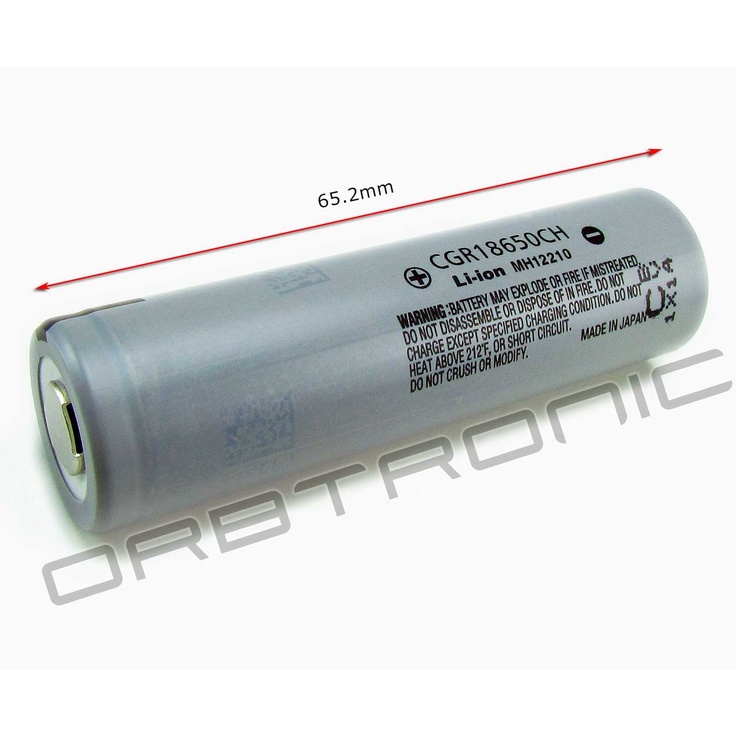 Gel cell batteries can be left
in the float charge mode for extended periods of time without damage.
This mode is often used to maintain gel cell batteries used in backup
power applications.
Gel cell batteries can be left
in the float charge mode for extended periods of time without damage.
This mode is often used to maintain gel cell batteries used in backup
power applications.
Precautions

References
Sealed Lead-Acid Batteries - Technical Handbook. Power-Sonic Corporation, San Diego, CA. (Available for download at www.power-sonic.com)
Sealed Lead-Acid Battery Chargers (Spec Sheet). Power-Sonic Corporation, San Diego, CA. (Available for download at www.power-sonic.com) Dated January 2000.
The ARRL Handbook for Radio Amateurs (1995). The American Radio Relay League, Newington, CT.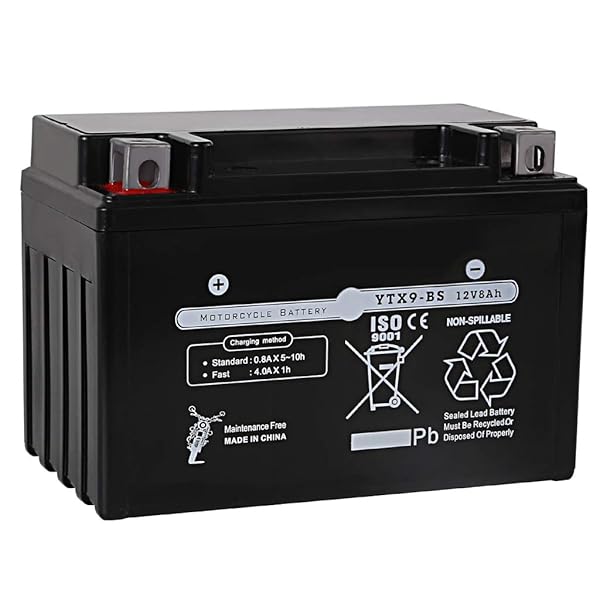 Chapter 11, pp 11.20-11.23.
Chapter 11, pp 11.20-11.23.
Disclaimer: This material is provided for general information only. Always follow the manufacturer's guidelines for the proper use, charging, handling, and safety of your gel cell battery.
From time to time, you may need to charge your ATV or UTV battery using an external charger. The bike’s own charging system does not always have the capacity to keep up with the battery drain even from regular use. Some new batteries will also need charging before use.
This guide will tell you how to charge any ATV or UTV battery and answer some of the most common questions people have about the charging process.
Page Contents
ATVs do have a built-in charging system that is powered by the bike’s engine.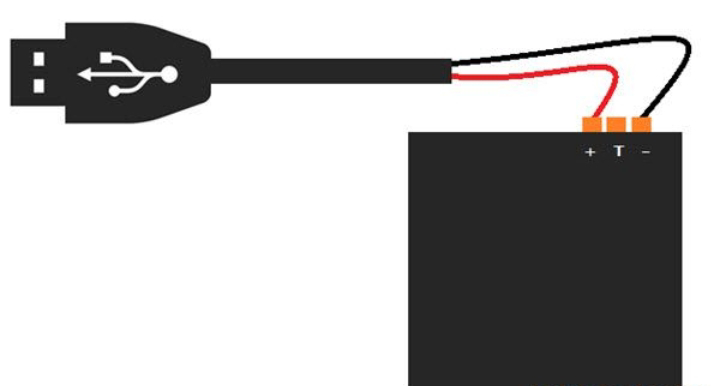 But the current it provides is not very high.
But the current it provides is not very high.
You can charge the battery by going for a long ride, but it’s not always practical. Instead, you may use an external battery charger.
Tools and gear required:
The battery and charger must stay dry during the whole charging process.
Also, the battery must be somewhere well-ventilated to vent out any gases from the charging process.
Overcharging or even just charging a battery causes a chemical process that releases explosive hydrogen gas. With proper venting, you minimize the risk of the gas gets ignited by a spark, which may cause an explosion.
A garage or shed where you can leave the garage door open would be a good location.
If you don’t have a dry and well-ventilated area that will fit your whole ATV, consider removing the battery from the bike to charge it.
The ATV and all accessories should be turned off when charging to prevent sparks.
You need to make sure you have proper access to the battery. Some ATVs will have their battery hidden behind a plastic cover that needs to be removed for access. Others have the battery readily accessible without removing any parts.
The battery on my Polaris Sportsman XP1000 is hidden under the front cargo rack cover.After locating the battery you should visually inspect it to look for cracks or other damages. Never attempt to charge a damaged battery!
Before you hook up the charger, you need to identify what type of battery you have.
Some types of batteries require a specific type of charger to charge properly, or that you add a few additional battery-specific steps to the charging process.
Here is a list of the different types of batteries you may find on an ATV or UTV, and how to tell them apart.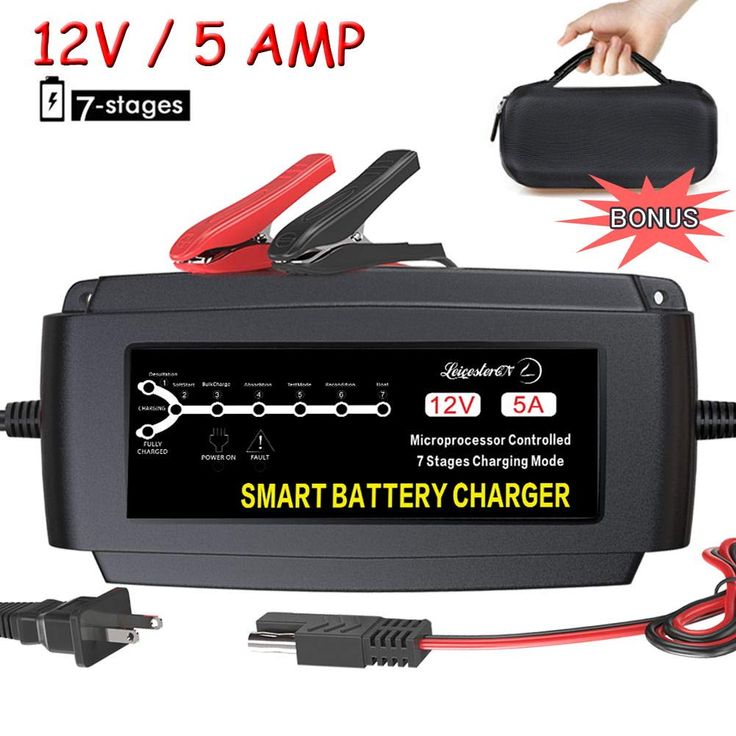
All batteries should have a label that indicates the battery-type, but sometimes these have worn off. Check out this post to learn what ATV battery numbers mean.
Also, look for a part number. A quick google search will tell you exactly what battery you have if you enter this number.
FLA batteries are a non-sealed wet-cell style of batteries that uses lead plates and liquid battery acid as an electrolyte. On top of the battery, there are removable caps, one for each cell. The caps are either threaded or pull-out style.
Another way of telling that you have an FLA battery is by its semi-transparent casing, where you will see the water level inside the battery. There are marks to indicate the maximum and minimum level of electrolyte.
FLA batteries only: Before you begin charging you should remove the caps to verify that the lead plates are covered by electrolyte fluid. Add distilled water if the level is below the minimum mark.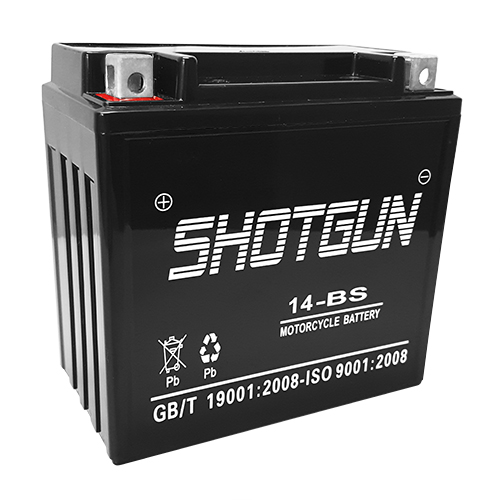
SLA and VRLA are different acronyms for the same type of battery. Their construction is quite similar to conventional flooded batteries, but there is one main difference.
If you overcharge a sealed battery, there is no way to open it to add more fluid. They have a flat top with no filling ports or caps. Never try to pry-open a sealed battery!
Type 3: Lithium-ion batteryThe easiest way to know that you have a Lithium-ion battery is to feel its weight. They weigh about 1/10th or less of other types of batteries.
Lithium-Ion batteries are much lighter than other ATV batteries.Gel-cells are also lead-acid batteries. But instead of being a liquid, the electrolyte is in gel form. GEL-cells are not that common on ATVs because they are more expensive and do not offer the same power capacity as the others on this list.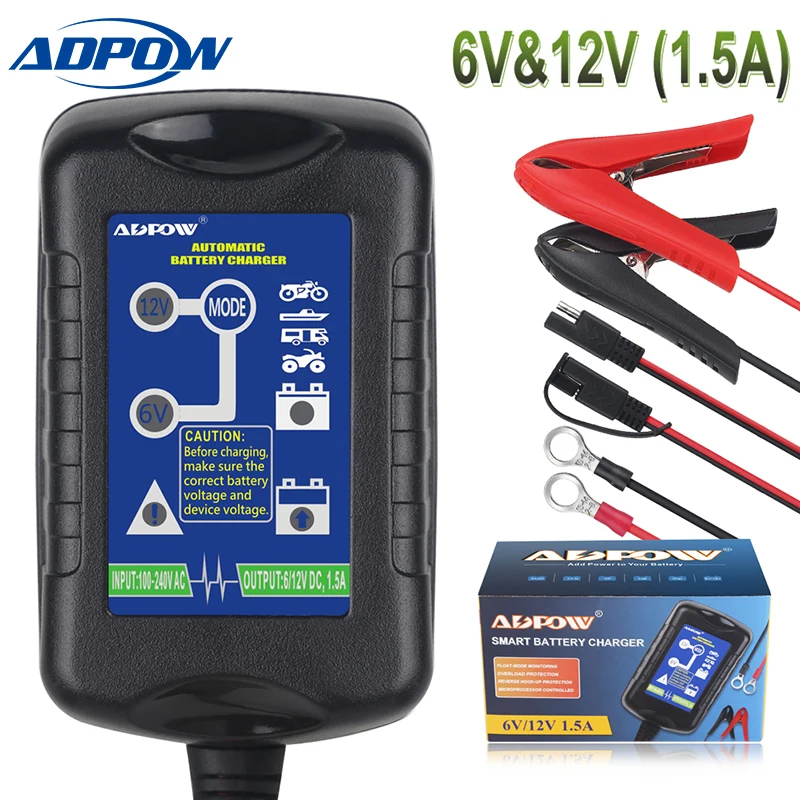
A GEL-cell battery looks very similar to an SLA battery because of its sealed flat top. One way to tell them apart is by shaking the battery. You should hear the battery acid splashing around inside an SLA battery, while you will hear nothing when shaking a gel-filled battery.
GEL batteries are not the best option for ATVs, but some use them.AGM batteries are another variation of a lead-acid dry-cell battery. They are completely sealed and have a fine sponge-like mesh of glass fibers inside.
As with the GEL battery, you won’t hear any movement inside when shaking an AGM battery. Other than their labeling, it may be hard to tell them apart. Look up the model-number online if you are not sure.
The battery on my Polaris Sportsman XP1000 is a real pain to reach. But luckily, I was able to see the part number through the wires. A quick google search reveals that it’s a YUASA 18.9Ah AGM battery.If you use the wrong type of charger for your battery type, or set up a manual charger incorrectly, overcharge or undercharge the battery which may cause permanent damage.
Using a good quality, intelligent charger that is compliant with your type of battery is the easiest way to charge your battery safely. Under certain conditions, you may also use a manual bench-style charger.
A quality intelligent charger will be able to charge a variety of different battery types.Here are some guidelines to what type of chargers you may and may not use on different types of ATV and UTV batteries:
For all ATV and UTV batteries
Flooded lead-acid (FLA) battery
These batteries are the least picky when it comes to choosing a charger. If you overcharge a flooded battery, you may just add distilled water. Any manual or automatic charger will work as long as they are the right voltage and have low-amp settings.
Absorbed glass mat (AGM) and sealed lead-acid (SLA) batteries
While it is possible to charge both AGM and SLA batteries with a manual charger, it is not recommended. If you don’t monitor the charging process carefully, you may overcharge, which would cause gassing and water depletion.
If you don’t monitor the charging process carefully, you may overcharge, which would cause gassing and water depletion.
Sealed batteries cannot be topped off, so the damage is permanent. That’s why it’s better to always use an intelligent charger for any sealed battery like AGM and SLA batteries.
Some, but not all intelligent chargers, will have a dedicated AGM charge mode. AGM and SLA batteries have a very similar charge profile. Therefore most brands of AGM batteries, as well as SLA batteries, will have no problems with any 12-volt intelligent battery charger as a charge source.
According to Optima (https://optimabatteries.com), a high-quality AGM compliant charger may improve battery performance and lifespan, but most battery chargers and maintainers will work just fine on Optima brand batteries and other AGM batteries.
GEL-cell battery
GEL-cell batteries are the most sensitive and require a very specific charge profile. The higher voltage from a flooded or AGM charger causes permanent hydrogen bubbles in the gelled electrolyte, which reduces battery capacity or ruin the battery altogether.
Never use a constant current manual charger to charge a GEL-cell battery, only a GEL-cell compliant intelligent charger. The charger should have reliable temperature sensing, voltage regulation, and a specific GEL-cell mode.
Lithium-ion battery
Technically you can charge a lithium-ion battery with a manual charger, but it is not recommended. If you don’t follow a specific procedure, you will damage the battery permanently.
It’s recommended that you only use a Lithium-ion compliant charger.
Lithium-ions charge fast and at a higher voltage. A manual charger or even a standard intelligent charger will likely undercharge a Lithium-ion battery, which may damage the battery over time.
This step is not mandatory if you use a fully automatic charger that you know is compliant with your type of battery. The charger will do the job of choosing the right charge profile for you.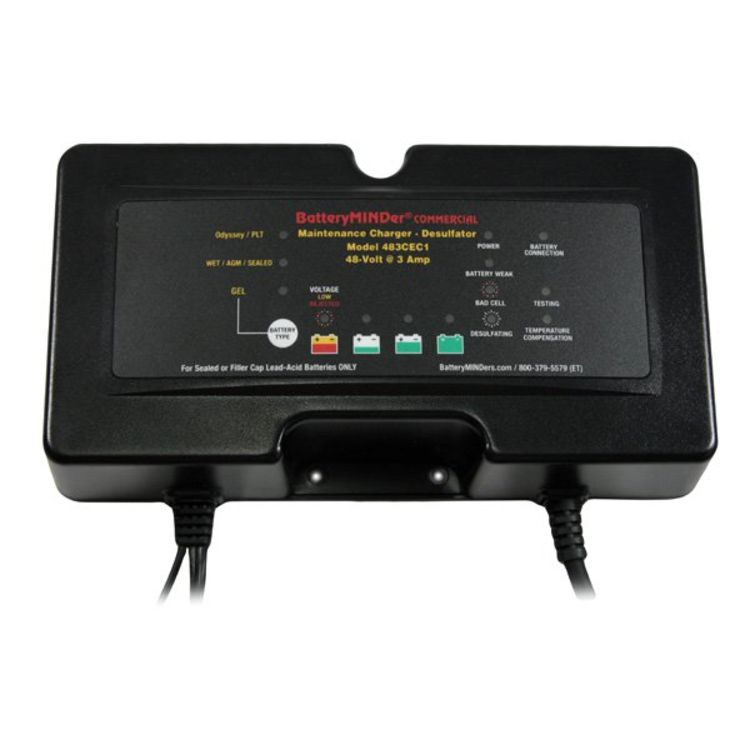
But if you use a constant current manual style of a charger, you need to know the battery’s voltage to be able to monitor the charging process.
In any case, the state of charge will tell you if your battery is completely dead or if it just needs to be topped off. It will also give you an indication of what charge time to expect.
Note that different types of batteries reach the same state of charge at different voltage levels.
| State of charge | Charge time |
| New (0%) | 14 – 20 hours or more |
| 75% | 3 – 6 hours |
| 50% | 6 – 10 hours |
| 25% | 10 – 14 hours |
A simplified formula to calculate the charge time of an empty battery is by dividing battery Ah rating with charging current in A (ampere). Charging a completely flat 15Ah battery with a 1,5A charger would take 10 hours.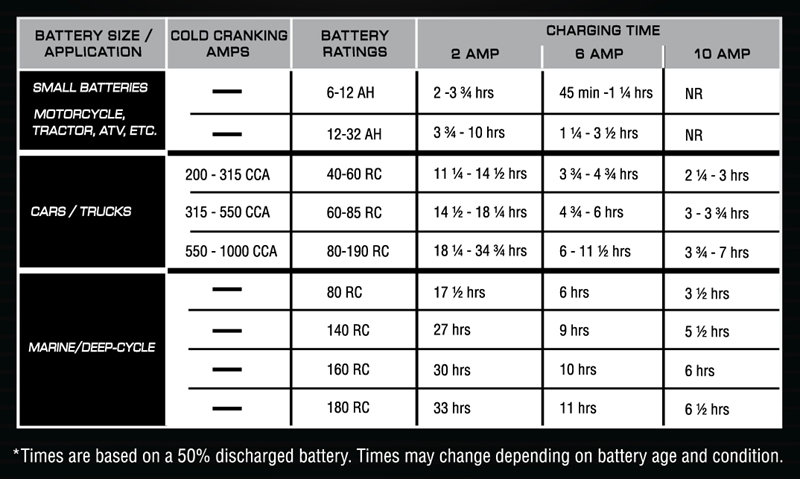
Charging times will vary depending on various factors:
If you have a smart battery charger, it will stop charging automatically as soon as the battery is fully charged. Usually, this should take no more than 12-16 hours unless the battery was completely flat.
Do not plug the charger to a wall socket yet.
Your charger has one positive lead and one negative lead. The positive lead will have a red clamp and the negative lead clamp will be black.
The red clamp will be connected to the positive battery terminal. To identify the positive battery terminal, look for one or more of these markings:
Make sure the terminal is clean to ensure a proper connection. Use a wire brush, and remember to wear your eye protection.
Use a wire brush, and remember to wear your eye protection.
The negative will be connected to frame ground. Look for a bare, solid metal part of the frame or engine. Bare metal bolts are often good options. Make sure your ground connection is clean as well.
When removing the first lead after charging, there might be a small spark. It’s best if this spark happens somewhere away from the battery where there is less risk of gas build-up from the charging process.
Modern intelligent chargers are designed not to overcharge the battery, so you will most likely have no issues if you choose to connect the negative lead directly to the negative battery terminal instead of the frame. After all, this is what most charger manuals will tell you to do.
Connecting it to the frame or engine instead just adds one more layer of safety.
From an electrical point of view, the battery will charge just as well whichever of the two options you choose.
Your negative battery terminal will have either:
Now that your connections are clean you can connect the charge leads.
Now plug the charger to a wall socket, but make sure it is not charging yet.
Manual charger
You need to set the charge rate (current) manually. A good rule of thumb to know what amperage your battery should be charged at is to divide its Ah- rating by ten. A 15Ah battery should use a charger with a power output of no more than 1,5A. You should never charge an ATV battery with more than 3A.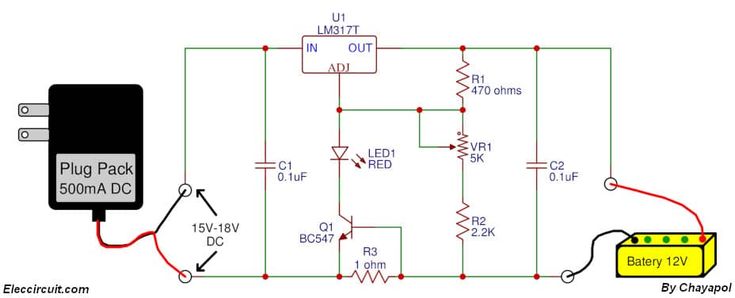
Intelligent charger
Choose the right charge-mode for your type of battery. Using the wrong mode on an intelligent charger or may overcharge or undercharge the battery.
You are now ready to initiate the charging process. Make sure you have enough time to charge the battery to full charge, or it will sulfate.
Do not attempt to start an ATV or UTV when connected to an intelligent battery charger.
For all types of batteries
You want to make sure the battery does not overheat during the charging process.
If the battery becomes warm to touch, turn off the charger, let it sit for a few minutes to allow any gasses to vent out before removing the charge leads. Let the battery cool off before you continue charging it.
For flooded lead-acid batteries
The electrolyte levels should be monitored during the charging process. If it falls under the specified level in any of the cells, you should remove the cap and add distilled water until you reach the correct level.
For manual battery chargers
A manual charger won’t turn off when the battery is fully charged. You need to monitor the voltage to keep track of the battery’s current state of charge. Use the table from step 5 as guidance.
When the state of charge is about 80%, you should turn down the amps to about half of what you started with. A lower amperage at the final part of the charging process will give you a slightly higher final charge rate, as well as reducing the risk of overcharging the battery.
When you reach a full state of charge according to the table, the charger must be switched off or put in a maintenance-mode if available.
Unplug the charger and let it sit for a few minutes to let any gasses vent before disconnecting the leads.
Use a piece of cardboard as a fan if you suspect gas buildup over the battery.
As long as the charger is unplugged, it doesn’t really matter which lead you to remove first.
But it is best practice to always start with the negative lead. There is no harm done if you accidentally touch ground with a negative lead.
Wait a few hours and use a voltmeter or multimeter to check if the battery still holds a charge. If the voltage drops, there might be a problem with internal sulfation.
It may be worth trying to charge the battery with a charger that has a specific desulfation mode before discarding the battery.
Read this guide to troubleshoot a battery that wont charge or won’t hold a charge.
The charging system on an ATV is not as effective as the one you will find on a car, so it will need more time to charge the battery properly.
Unless you do hour-long rides every time you start up your bike, it will likely draw more power to start the bike than it will be able to charge while you are running it.
In addition, ATV batteries are relatively small in both size and capacity to keep the overall weight of the bike down.
Combine that with a few power-hungry accessories like your ATV winch, and you will soon find your battery too low on power to start your bike. Leaving the battery on a low charge over time will also cause damage to the battery.
That’s why it’s a good practice to charge it now and then to save you from problems down the road.
ATV batteries should be charged any time the battery voltage drops below 12.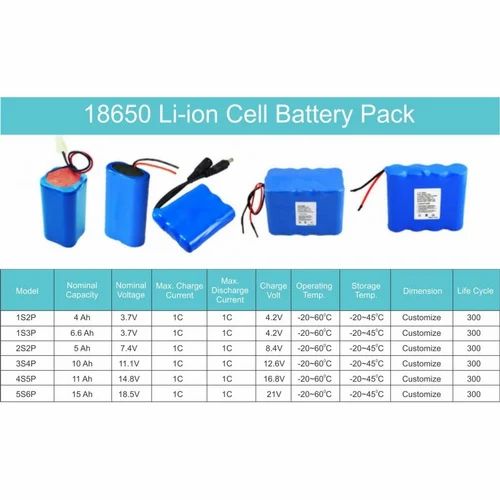 4 – 12.6 volts. Top off the battery each fall and each spring, and use battery tender to keep the battery healthy when the ATV is sitting for long periods without being used.
4 – 12.6 volts. Top off the battery each fall and each spring, and use battery tender to keep the battery healthy when the ATV is sitting for long periods without being used.
A battery should be charged at three different stages for optimal performance and service life. An intelligent charger switch between the stages automatically.
Automotive-style manual chargers do not have proper regulation for charging in stages. If you charge the battery too hard at the final stage, it won’t be able to reach a full charge.
The three charging stages are:
Bulk stage: At this stage, the battery will be charged up to about 70-80% of its capacity. The charger will be putting out a constant current determined by what charge mode or amp settings you have chosen. The voltage will increase gradually.
Absorption stage: At this stage, the charger will maintain voltage to the battery, but will taper off the charging current gradually as the battery gets closer to a full charge. This allows you to reach a higher state of charge without the risk of overcharging the battery.
This allows you to reach a higher state of charge without the risk of overcharging the battery.
Float stage: At this stage, the battery will be fully charged. All the charger is doing providing a small maintenance charge to keep the battery fully charged. Both voltage and current will be reduced.
Intelligent chargers usually have different charge modes to choose from. Each charge mode will have a specific set of parameters that are optimized for different types and different sizes of batteries.
The charger uses microprocessors to collect information from the battery to see its current state of charge and to adjust the voltage and current accordingly.
For example, a lithium battery reaches 80% state of charge at a different voltage than a flooded lead-acid battery and needs the voltage input to be adjusted accordingly. And a gel battery cannot take as high of a charge rate as an AGM battery and will require a lower amperage.
All of these parameters are controlled by which charge mode you choose. Your chargers user manual will tell you more details about each charge mode your specific charger offer.
In general, there is no need to disconnect the battery terminals when you are charging an ATV or UTV battery, as long as you are using a fully automatic charger or a trickle charger at 1,5A or less.
Hooking up a high current booster charger, however, may cause a voltage spike that may damage your bike’s electronics. But you should never use a high-amp manual style charger on an ATV in any case, so this should be a non-issue.
If your bike, for some reason, has a high phantom drain, you may struggle to get any power to the battery. In this case, you should remove the negative terminal before charging your battery. Then you need to do some troubleshooting to identify what is draining your battery.
Also, please note that boosting your battery by hooking it up to another ATV using non-protected jumper cables may create a voltage spike that has the potential to damage your bike’s electronics.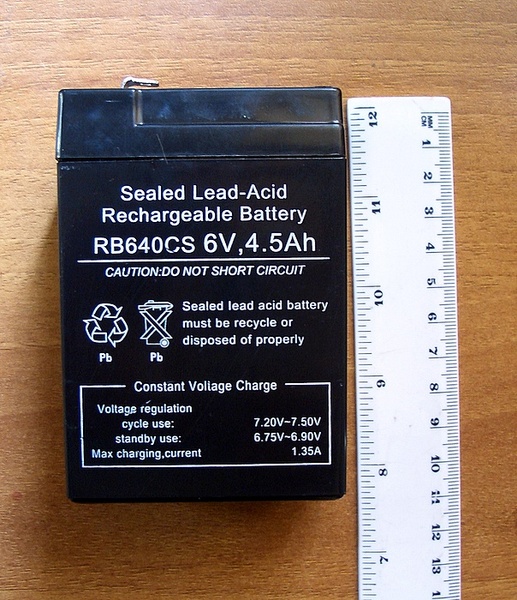 Always use cables that have built-in electronic protectors, and you should be fine.
Always use cables that have built-in electronic protectors, and you should be fine.
For basic maintenance charging, where you are just topping off a battery that seems a bit low on power, there is no need to remove the battery from the bike.
When you are charging a brand new battery that has never been charged before or a battery that has gone completely dead, you might want to consider removing it.
When doing a deep-charge, there is a slightly bigger risk for explosive hydrogen gas to build-up, as well as possible overheating.
By removing the battery from the ATV, you won’t cause any harm to the bike in the unlikely event that something goes wrong.
Flooded lead-acid batteries have removable caps to add more electrolyte fluid (distilled water) if needed. There is one individual cap for each cell or a strip that ties several caps together.
Some believe that you always need to remove these caps when you charge to let out any gas build-up. This is usually not necessary. Those caps are designed to vent any gas produced while charging, or there will be a separate vent.
Refer to your specific battery’s safety instructions to verify whether the caps need to be removed or not.
As long as the vents are not blocked (stuffed with mud, anyone?), you should have no issues leaving the caps in.
The only time you need to remove the caps is when you wish to check the level of electrolyte or top off one or more cells that are low on fluid.
When using a manual charger, you can remove the caps for a short period to give you an indication of when the charging process is finished.
When you see hundreds of bubbles forming on top of the battery cells, you know that the battery is full. Any further charging is overcharging.
PS! Remember that the gas you see forming is flammable, and the fluid is acidic.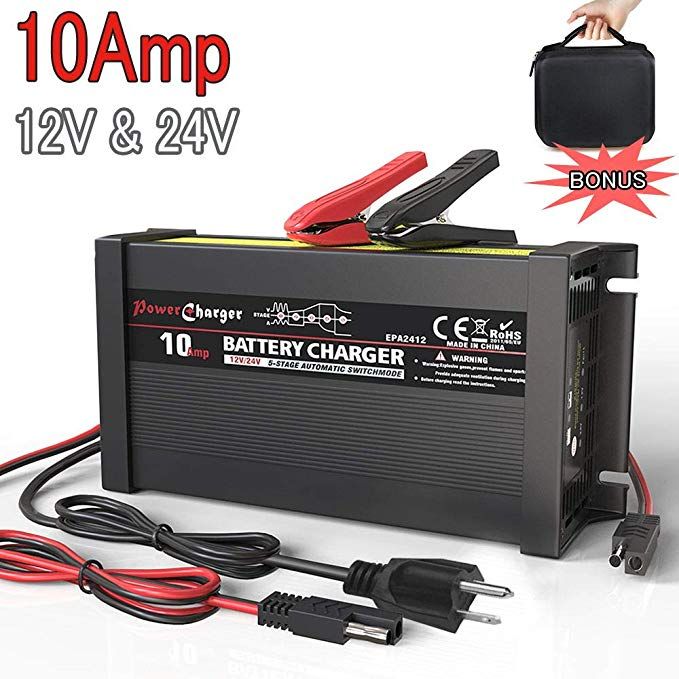 Never remove battery caps without wearing eye protection and vinyl gloves.
Never remove battery caps without wearing eye protection and vinyl gloves.
The charging process described at the top of this post will work both for doing a deep charge on a new battery as well as doing a refresh charge to top off a battery where the voltage has dropped a bit too low.
There are, however, a few things to keep in mind.
 Before you can charge the battery, you need to activate the battery by adding the battery acid to the battery according to the manufacturer’s instructions. The process of adding the battery acid to the battery is usually thoroughly explained in the instructions that come with the kit, so we won’t cover this process in this post.
Before you can charge the battery, you need to activate the battery by adding the battery acid to the battery according to the manufacturer’s instructions. The process of adding the battery acid to the battery is usually thoroughly explained in the instructions that come with the kit, so we won’t cover this process in this post. If you hook up the charger, but it fails to initiate it’s charging cycle, the battery voltage may have dropped below the minimum threshold recognized by the charger.
To solve this, you can use a fully charged battery to trick the charger into starting the charging process.
Tools and equipment required:
Follow these steps:
 Connect the other end of the negative lead to frame ground, or the dead battery’s negative terminal if the battery is not installed in the ATV.
Connect the other end of the negative lead to frame ground, or the dead battery’s negative terminal if the battery is not installed in the ATV.You should not use a car charger or a typical trickle charger to charge an ATV unless it has specific settings to limit the amp output as low as 1-3 amps. Car chargers typically come with an output of 10A. Charging an ATV battery at 10 amps would overheat it and damage it permanently.
You can use jumper cables to jump-start an ATV battery from a car battery, but it is not a suitable method for doing a full charge. The car must stay off as long during the whole process.
Author:
Sergey Kurtov
Reading time: 5 min
Publication date: 18-02-2022
Article rating early: (2921)
Content
Anyone who has a car, motorcycle or scooter late purchases a charger, or borrows it from friends to recharge the battery. Most commonly used in vehicles are lead-acid batteries with liquid or adsorbed electrolyte (AGM). In backup power systems, gel batteries are more often used, which also need to be recharged. Only now the charge parameters can differ significantly from those suitable for car batteries.
Most commonly used in vehicles are lead-acid batteries with liquid or adsorbed electrolyte (AGM). In backup power systems, gel batteries are more often used, which also need to be recharged. Only now the charge parameters can differ significantly from those suitable for car batteries.
Users often have homemade or simple car chargers on hand. This raises logical questions: how to charge a gel battery with a conventional charger? Is it possible to use handicraft and automotive appliances? What is the allowable charge current for a gel battery? Let's briefly go over these issues.
Despite significant differences, gel batteries are still lead-acid batteries. However, charging gel batteries with conventional chargers is not always possible. If we talk about handicraft memory, then the answer is obvious: they are not recommended to be used for any batteries. Not only do they not have enough "brains" to control the charging process, their operation can be dangerous both for the battery and for the surrounding area.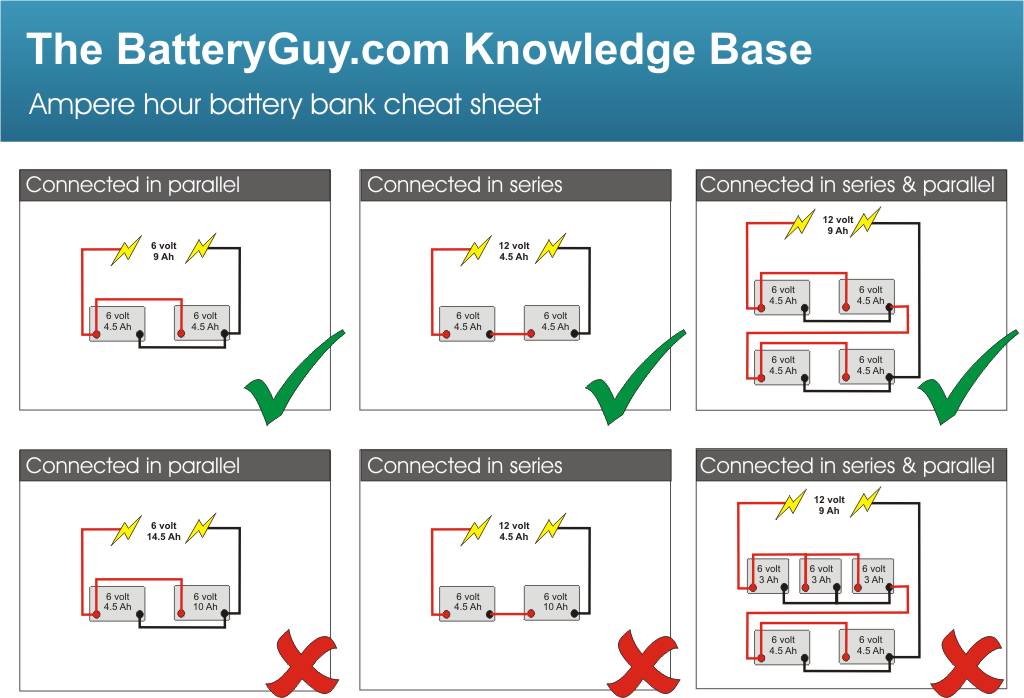 If you want to ensure long battery life, get rid of such a relic of the past as a homemade charger.
If you want to ensure long battery life, get rid of such a relic of the past as a homemade charger.
If we are talking about a simple car charger, albeit a factory one, you should carefully read the characteristics issued by it. Gel batteries are the most sensitive to charge parameters among all types of lead-acid batteries. Current and voltage must clearly correspond to the parameters indicated on the label. What happens if you charge a gel battery the wrong way? With prolonged exposure to high currents, the battery may not be able to cope with the excess of gases released and simply swell. Such a battery is unusable and must be disposed of. AGM batteries handle this problem somewhat better, venting gases through relief valves and simply losing electrolyte levels. Although there may be swelling. It's just not that easy to summon him.
Therefore, the easiest way to carry out a quality charge with normal parameters without any outside control is to use a suitable automatic charger.
If you decide not to purchase the appropriate charger, or there is no such possibility, you will have to think about how to properly charge the gel battery.
Be sure to find out (using an indicator or a voltmeter) what voltage the charger delivers. Many gel batteries do not allow voltages above 14-14.5 volts to be applied to the terminals. If the device gives out more and, at the same time, there are no built-in means of adjustment, the charge should be abandoned. Yes, there are many "popular" ways to lower the output voltage, but all this, as mentioned earlier, is not safe.
The charge current should traditionally not exceed a tenth of the capacity. Sometimes higher values are allowed in the initial stages of charging, but as the charge level is replenished, the current should decrease to the minimum values. All allowable charge values, as always, are marked on the label of any battery. When using a charger without "brains", it is desirable to control the process. In the absence of means of indication, control will turn into an unpleasant routine.
In the absence of means of indication, control will turn into an unpleasant routine.
Don't lose your vigilance when using smart chargers. Many memory devices have different modes of operation. Be sure to have a fast charging mode on some device, when an increased voltage and, as a result, current is applied to the terminals. The gel battery in this case may begin to actively emit gases and swell. Therefore, such regimes should be treated with caution. It is much better to set the mode, which manufacturers often call "storage". This mode, available on many smart chargers, requires charging up to a low voltage (13.2 - 14V). In this mode, you can not only safely replenish the charge, but also, for example, leave the battery for storage as unnecessary, maintaining a high charge level. Excellent storage mode, for example, is implemented in the Auto Welle AW05-1204 charger. This unit enters storage mode automatically. This mode consists in raising the charge voltage to 13.2V, after which the device expects self-discharge to 12.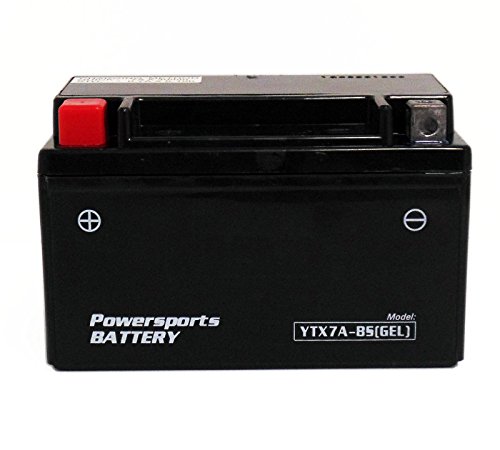 8V. Having fixed this value, the battery is charged again to 13.2V. This approach will positively affect the life of any type of lead-acid battery.
8V. Having fixed this value, the battery is charged again to 13.2V. This approach will positively affect the life of any type of lead-acid battery.
To summarize. There is no trick to properly charging even the most sensitive gel batteries. You should carefully read the allowable current and voltage values, and check these parameters with the charger. The most reasonable solution would be the correct selection of a smart charger, which will not only safely replenish the battery charge, but also timely transfer it to storage mode, maintaining the voltage at a high level until needed. There are many chargers that have preset modes for charging gel batteries. Using such a memory instead of a handicraft one, you not only free yourself from the need to control the process, but also significantly extend the battery life. Many users are forced to replace the battery much earlier than the stated life, not because the battery is bad, but because the operation was carried out with violations, and the most common violation is the failure to comply with the required charge parameters.
How to charge a gel battery with a conventional charger 5 from 5 based 2 ratings.
Buying a children's ATV or its adult counterpart is not just about being a rider. This technique requires special attention. As a rule, the owners of this motorcycle often do not pay enough attention to charging the battery, which can cause it to fail almost every season. Remember, if you charge your ATV battery correctly, it will last you many times longer.
To avoid premature battery failure and loss of battery capacity, follow these guidelines:

Always follow the connection diagram when installing the battery in the ATV. You need to start by connecting the positive terminal. Be careful not to reverse the polarity as this can cause both the fuse to blow and the battery to explode.
If the vehicle battery suddenly stops charging, there may be several reasons for this:
The first signs of regulator relay failure are when the ATV battery begins to drain too quickly. Diagnosis of such a breakdown is carried out by measuring the resistance with a voltmeter at the battery terminals. Repairing any electrical equipment of an ATV is a rather complicated process that a true professional should perform.
Often the best solution when a battery or regulator fails is to replace it with a new one.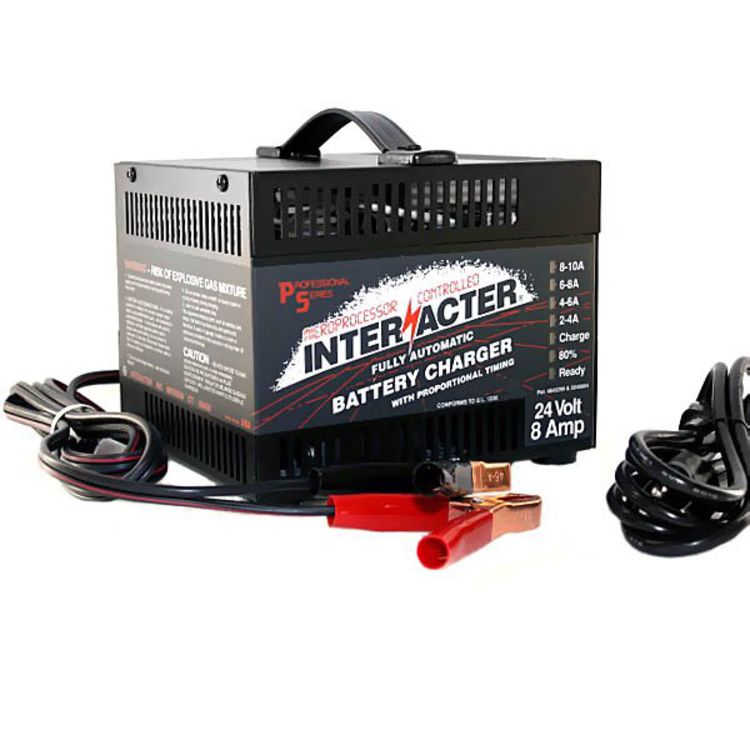 It is much easier to prevent this kind of breakdown than to fix it later. That is why it is necessary to charge the battery of motor vehicles in strict accordance with the requirements of the manufacturer.
It is much easier to prevent this kind of breakdown than to fix it later. That is why it is necessary to charge the battery of motor vehicles in strict accordance with the requirements of the manufacturer.
There are two ways to charge the child's ATV battery with the charger. The easiest of them is to connect the charger to the appropriate connector on the motorcycle. True, such a nest is not available on all models of ATVs. If there is no such connector, then the battery should be connected directly to the charger. The battery is charged as follows:
Lithium ATV batteries usually have a board that monitors the battery level.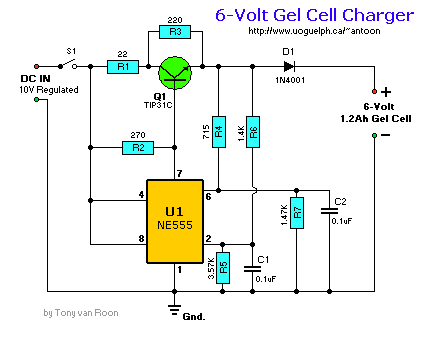 But even in this case, it is strongly not recommended to charge the device longer than necessary.
But even in this case, it is strongly not recommended to charge the device longer than necessary.
Each ATV gel battery manufacturer provides detailed charging instructions. It is very important to choose the right charger with the ability to adjust the amperage in order to avoid overcharging the battery. On sale you can find specialized chargers for ATV gel batteries.
It is necessary to charge such a battery as follows:
